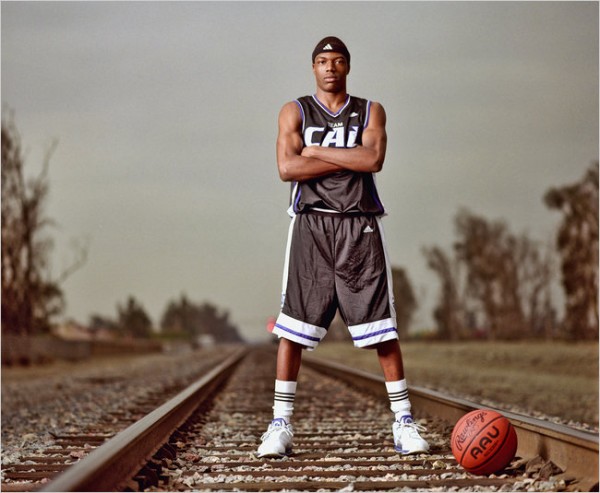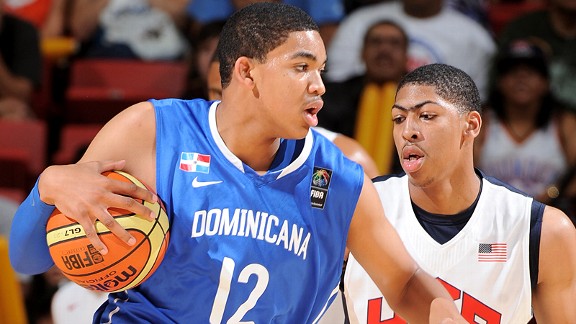College Basketball is Far More Than a Four-Year Mission
Posted by Chris Johnson on July 15th, 2013Chris Johnson is an RTC Columnist. He can be reached @ChrisDJohnsonn.
The lengths parents will go to control and obsess over their children’s youth sports development are legion. The process begins as far back as grade school when children with exceptional athletic talents are weaned off other athletic exploits and forced to devote hours upon hours to the sport their parents have identified as the one most likely to offer an expedient (and financially permissive) path through college, and for the best of the best, all the way to a professional career. Recent NBA draftee Shabazz Muhammad’s infamous age-change is the latest example, but there are countless other cases involving kids whose participation in youth athletics becomes more about the potential awards down the line – college scholarships, professional fame, shoe contracts, and the like – than the pure, blissful, unbridled joy typically inhering childhood athletic competition. Try the recent Wall Street Journal profile of 15-year old New Yorker Jerron Love, a supremely talented prospect with hyper-controlling parents who went as far as to start posting YouTube clips of their son at 11-years old titled, “Jerron Love 11 Year Old Basketball Phenom.” There’s also, more famously, the curious case of Demetrius Walker, chronicled in George Dohrmann’s tremendous book Play Their Hearts Out, which details the rise and fall of a 12-year-old hoops phenom deemed the absolute surest of “sure thing” prospects before said sureness ever reached a high school basketball court. Now more than ever, elite sports at the youth level are becoming a more career-oriented endeavor, replacing athletic enjoyment with long-term professional thinking. This shift in thinking has, naturally, gripped youth basketball at disturbingly young ages.

One of the biggest recruiting busts in recent memory, Walker is a popularized example of today’s warped youth basketball culture (Getty).
It has reached the point where, for some prospects, a typical, uninterrupted, seamless progression through middle school is less important than preparing oneself in the most opportunistic way for the recruiting evaluation cycle. How do I know? A recent article in The Star-Ledger provided the newest detail to a culture of elite youth basketball that has officially become a professionally motivated enterprise, wherein some of the country’s most highly touted recruits are repeating grades in middle school to maximize exposure to college coaches and better position themselves to leverage a crucial evaluation window to their greatest possible benefit. All four of New Jersey’s most highly rated prospects in the 2014 and 2015 classes repeated grades, and other big-name talents – including 2013 stars Andrew Wiggins (Kansas), Noah Vonleh (Indiana), Wayne Selden (Kansas), and lottery pick Nerlens Noel – have made the same choice. This is not a new practice. ESPN recruiting analyst Dave Telep, cited in writer Mathew Stanmyre’s article, states, “The genie is out of the bottle. It’s no longer a trend – it’s an accepted practice within high school basketball.” The thinking behind the move is simple: artificially place oneself in a younger age group so as to grant oneself the physical and skill advantages that come with facing a lesser level of competition. That’s the basic idea, but there are a few dynamics at work here, all of which go into making this practice not only a smart and efficient way to elevate one’s relative prep hoops standing, but a wise early career move.
The trend underpinning this entire development is the modern college basketball recruiting process, which now begins, for the select few cant-miss up-and-coming phenoms, as far back as seventh and eighth grade. Whereas players used to be scouted, contacted, and offered scholarships after already establishing themselves through multiple years of high school and AAU competition, the best of the best are well-known entities before ever setting foot on a high school campus. High school coaches, fans and media take up the insane task of trying to project what 12-year-old players will look like six years down the road. There are sites dedicated to posting future class rankings… for 2018. Former Kentucky coach Billy Gillipsie infamously offered a scholarship to an eighth-grader. The point is, recruiting begins earlier than ever these days; if your basketball talents project favorably at the elite college level, odds are someone is going to find out, write about it, probably piece together a YouTube montage and post it on the Internet. Unsavory and unseemly as it seems, it is just where we are today with youth basketball recruiting.
More interesting to me is the long-view approach that underlies this growing trend. One of the players highlighted in the article is Karl Towns Jr., a 2014 Kentucky commitment who repeated a grade after transferring from a public to a private school. Towns was an exceptional middle school prospect identified by John Calipari early in his high school career (and quite possibly well before that). He was selected for Calipari’s Dominican Republic Olympic qualifying squad in summer 2012, and committed to Kentucky months later. Before announcing his college choice, Towns did something else: He reclassified to the class of 2014. That allowed Towns, a likely future first-round draft pick and a consensus top-10 player in 2014, to skip his junior year of high school and expedite his path to Lexington and, presumably, the NBA. His father, Karl Towns Sr., went on record to explain the move: “It will get him closer to his dream of one day playing in the NBA. Let’s be realistic: He’s left a legacy already at St. Joe’s [Towns’ high school] from what he’s already accomplished. There’s not much more.”
What Towns did, when you really think about it, is a prudent and forward-thinking decision. He and his parents made a calculated choice in middle school, knowing he would eventually become one of the more sought-after prospects on the college level, to repeat a year, allowing Towns to mature mentally and physically, elevating his relative standing against younger competition. Towns was more highly regarded in the 2015 class than he is 2014, which only makes sense – older players are not only more mature physically (this is especially important, given the rapid physical development – i.e., puberty – kids typically undergo between the ages of 12-16), they have an extra year of training and basketball IQ to polish their skill sets. They are better prepared for the college game, and their age, naturally, makes them, on the whole, more highly-sought after prospects than players one year younger. By repeating a year of high school, Towns turned this otherwise unavoidable age discrepancy into a beneficial recruiting development. After getting held back one year in middle school, Towns – an already hugely talented prospect in his own right – became an even more feted name within a younger pool of players. Having secured a college future at the most efficient college-to-NBA pipeline across the country, Towns essentially reversed his middle school repeat by reclassifying to 2014. He skipped his junior year of high school, undoing the extra year he underwent in middle school, to streamline his progression to his college hoops destination.

The move to repeat a grade in middle school, then reclassify in high school, guided Towns’ progress from middle school to, after his senior year of high school, college (Getty).
And so we come full circle. Not all players who stay back a year decide to reclassify as the two moves are not necessarily linked. The players who do, like Towns, are able to fast-track their journeys to college and professional basketball. For those who don’t, the move remains a massive age-related boon nonetheless: Gain an extra year of physical and skills-based training to enhance one’s stature during seminal college evaluation years, flash a more polished (and physically superior) game against younger and comparatively less-developed players, and be vetted and dissected and evaluated in a class one-year behind what one might otherwise elect to enter. (Think about it this way: Before his classification, Towns was arguably the top player in the 2015 class. In 2014, he is “merely” a top-10 player).
There is also the benefit of playing and competing against younger and physically less-mature competition. One of the best examples of this comes from Malcolm Gladwell’s landmark book “Outliers,” in which he details how the rosters of top Russian and Canadian hockey teams are comprised mostly of players born in the first few months of any given year. The age distinctions in youth hockey, as Gladwell explains, are based on calendar years, which means the oldest (and thus more physically mature, and, on balance, more skilled) players in any age group are born in January and February. A few months’ difference may not mean as much at the college or professional level, but in the context of youth sports, where children are still absorbing instructive wisdom, learning new skills and developing physically at rapid rates, the discrepancy makes a pronounced difference. The other players are left at a disadvantage to their older competition. I experienced a similar situation during my former youth soccer days, where my December 31 birth date placed me into the 1992 Olympic Development Program (ODP) age group. I was a member of the New Jersey state team, and came exceedingly close to making the “regional” team. Had I been born one day later – I never forgave my mother for this – I likely would have stood a better chance of making the cut within the 1993 age bracket. So yeah, New Year’s parties are cool and all, but if you’re a serious youth soccer player involved in the ODP program, a December 31 birthday is the most unenviable birth date possible.
Back to the main point. This newest trend adds another disconcerting twist to a me-first youth basketball culture gaining a more pervasive influence earlier and earlier in a child’s development. Elite college basketball is no longer a college, or even a high school, endeavor. Preparing oneself for a serious hoops career is now more than ever a lifelong process. This is disappointing, and kind of crazy. Middle school sports should be as much about making friends and smiling at onlooking girls during games and filling afternoons with some purely enjoyable athletic fun. This is a naïve characterization, as you probably now realize: The motivation to train and push for tangible monetary goals (scholarships, professional contracts) begins long before these goals become readily attainable. Kids and their parents are taking control of their basketball desires and professional goals as early as possible.












































